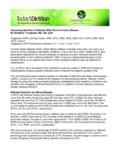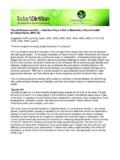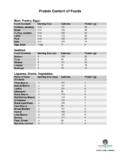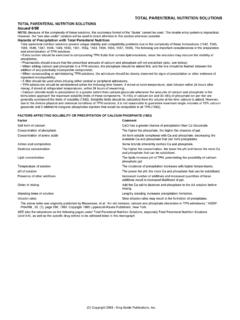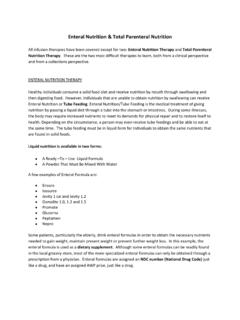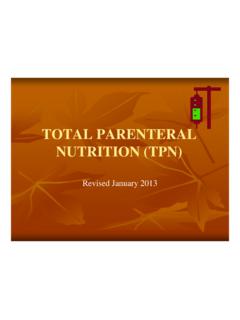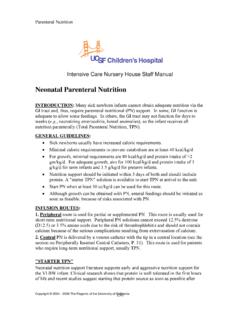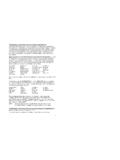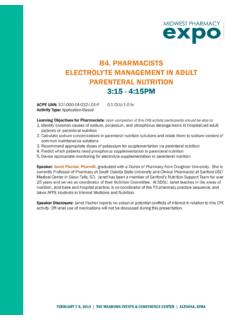Transcription of Fluid and Electrolytes in Adult Parenteral Nutrition …
1 Fluid and Electrolytes in Adult Parenteral Nutrition By Theresa Fessler, MS, RD, CNSC Suggested CDR Learning Codes: 2070, 3040, 5440; Level 3 Body Fluid and serum electrolyte concentrations often become imbalanced in patients who require Parenteral Nutrition (PN) due to one or more factors, such as physiologic stress, wound drainage, blood loss, gastrointestinal Fluid loss, organ malfunction, hormonal abnormalities, IV Fluid use, various medications, and even unavoidable shortages of Parenteral electrolyte products. It s important to discuss each patient s clinical status with the physicians, pharmacists, and nurses involved in the patient s care to become fully informed about his or her clinical situation.
2 With knowledge of Fluid and electrolyte requirements, the conditions in which these needs are altered, and the physical signs of excesses or deficits, RDs can determine safe and reasonable adjustments to PN electrolyte content. This continuing education course focuses on the role of Fluid and Electrolytes in PN and the clinical situations in which water and Electrolytes may need to be adjusted in PN. It s intended for practitioners who have a good basic knowledge of and experience with PN. Part 1: Requirements for Water and Electrolytes and Units of Measurement The Institute of Medicine lists the Dietary Reference Intakes for oral nutrients in milligrams or Parenteral and oral requirements are, of course, different because intravenous administration bypasses normal digestion and absorption.
3 For IV fluids and PN, the milliequivalent (mEq) is the unit of measurement used for sodium (Na), chloride (Cl), potassium (K), magnesium (Mg), calcium (Ca), and acetate, while the millimole (mM) or the milliequivalent can be used for phosphorus (P).2,3 Electrolytes are compounds or substances that dissociate in the solution to release positively and negatively charged ions that can carry electric current thus, the term electrolyte . A milliequivalent measures chemical-combining capacity, or the number of electrolyte atoms that will combine with 1 mEq of another electrolyte . Milliequivalents can be calculated from milligrams using this formula: A millimole is the amount of a substance equal to its atomic weight expressed in milligrams.
4 Phosphorus is measured in millimoles because at a physiologic pH of , the phosphate ion exists partly in divalent and partly in monovalent forms. The ratio is 4 mM of hydrogen phosphate (divalent, HPO4 2-) to 1 mM of dihydrogen phosphate (monovalent, H2PO4 - ). Thus, for every 5 mM of phosphorus in the bloodstream, there are four divalent ions (4 x 2 = 8) and one monovalent ion, making nine total valence electrons, and since 9 5 = , the valence ,4 Millimoles can be calculated using this formula: Table 1 shows adults oral and Parenteral water and electrolyte requirements, and Table 2 shows the relationship among milligrams, grams, milliequivalents, and millimoles.
5 Refer to Table 2 to do calculations in the two previous equations. Table 1: Oral and Parenteral Requirements for Water and Electrolytes Component Daily Oral Requirements (Dietary Reference Intakes for adults1*) Daily Estimated Requirements for Parenteral Nutrition2 Salt Form Used in Parenteral Nutrition Solutions5 Water to L 30 to 40 mL/kg Sodium g (ages 19 to 50) a g (ages 51 to 70) g (ages 70 and older) 1 to 2 mEq/kg Sodium chloride Sodium acetate Sodium phosphate Chloride g (ages 19 to 50)a 2 g (ages 51 to 70) g (ages 70 and older) As needed for acid-base balance Sodium chloride Potassium chloride Potassium g a g (lactation)
6 1 to 2 mEq/kg Potassium chloride Potassium acetate Potassium phosphate Magnesium 310 (females) and 400 (males) mg (ages 19 to 30)b 320 (females) and 420 (males) mg (ages 31 and older) 350 to 360 mg (pregnancy) 310 to 320 mg (lactation) 8 to 20 mEq Magnesium sulfate Calcium 1,000 mg (ages 19 to 50)b 1,200 mg (ages 51 and older) 10 to 15 mEq Calcium gluconate Phosphorus 700 mgb 20 to 40 mM Sodium phosphate Potassium phosphate a AI = Adequate Intake; b RDA = Recommended Dietary Allowance Dietary Reference Intakes from: Dietary reference intakes and application. Institute of Medicine website. Last updated September 12, 2011.
7 Accessed July 8, 2012. Table 2: Relationship of Milligrams, Grams, Milliequivalents, and Millimoles3 electrolyte Atomic Weight Valence Weight of 1 mEq Weight of 1 mM 1 mM equals mEq/g mM/g Sodium 23 1 23 mg 23 mg 1 mEq Chloride 1 mg mg 1 mEq Potassium 39 1 39 mg 39 mg 1 mEq Magnesium 24 2 12 mg 24 mg 2 mEq Calcium 40 2 20 mg 40 mg 2 mEq 50 25 Phosphorus 31 mg 31 mg mEq The electrolyte content of PN is labeled and ordered on a per liter or per day basis, depending on a pharmacy or health care system s typical first bag of PN can contain standard Parenteral electrolyte amounts as outlined in Table 1 or typically contains a hospital s established standard amount.
8 Dosing all PN components on a per day basis can help reduce errors, especially when the solution s total volume is changed. For example, the standard daily electrolyte content for PN at the University of Virginia Health System is 63 mEq Na, 72 mEq K, 18 mEq Mg, 18 mM P, mEq Ca, and 53 mEq These amounts change depending on a patient s needs and clinical conditions or sometimes because of nationwide shortages in various Parenteral electrolyte Test Your Skills With These Practice Questions Note: The graded examination follows the article. 1. How many milligrams are in 70 mEq K? A. 2,730 B. 4,500 C. 5,000 ANSWER: A 2.
9 A patient s PN contains 20 mM P. How is that expressed in milliequivalents and milligrams? A. 11 mEq; 1,000 mg B. 36 mEq; 620 mg C. 42 mEq; 600 mg D. 620 mEq; 20 mg ANSWER: B Explanation: Use the equations in the text (image 1 and image 2) and the information found in Table 2 to answer these questions. Part 2: Water and Sodium Water is necessary for biochemical reactions within cells, regulating body temperature, maintaining blood volume, transporting nutrients, and removing waste Total body water varies depending on a patient s percentage of fat and lean tissue, but in general it s estimated at an average of 60% of body weight for men and 50% of body weight for RDs need to adjust the water in PN depending on patients intake and output.
10 Water intake for the PN-dependent patient comes from IV fluids and, in some cases, oral intake. In addition, 300 mL water per day is generated from the oxidation of carbohydrate, protein, and fat . Water is lost from the body via urine, gastrointestinal fluids, wound drainage, chest tubes, and blood loss as well as insensible Fluid loss from skin and lungs. Insensible losses for the average Adult are approximately 800 to 1,100 mL/day and can be increased in certain conditions such as fever and Two main compartments contain total body water: intracellular Fluid (ICF), or water found inside cells, and extracellular Fluid (ECF), or water found outside cells.
